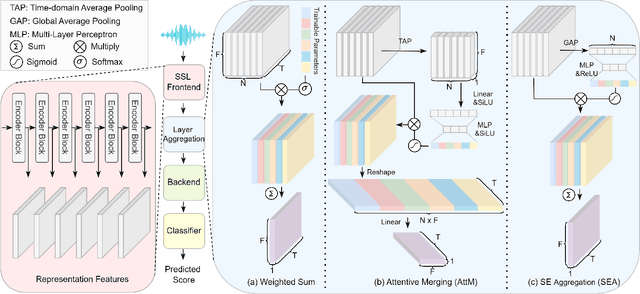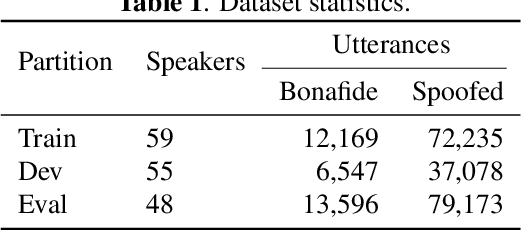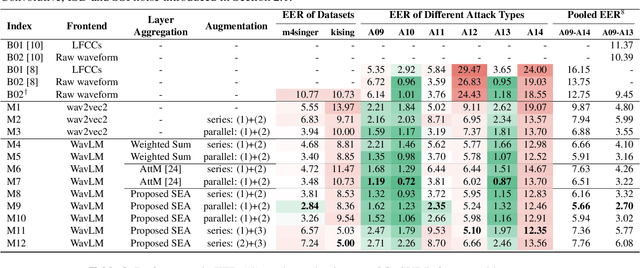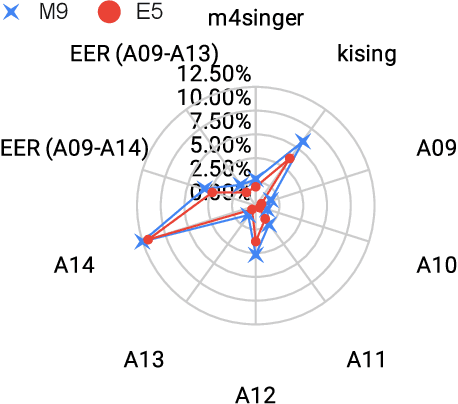Hardik B. Sailor
MERaLiON-SpeechEncoder: Towards a Speech Foundation Model for Singapore and Beyond
Dec 20, 2024Abstract:This technical report describes the MERaLiON-SpeechEncoder, a foundation model designed to support a wide range of downstream speech applications. Developed as part of Singapore's National Multimodal Large Language Model Programme, the MERaLiON-SpeechEncoder is tailored to address the speech processing needs in Singapore and the surrounding Southeast Asian region. The model currently supports mainly English, including the variety spoken in Singapore. We are actively expanding our datasets to gradually cover other languages in subsequent releases. The MERaLiON-SpeechEncoder was pre-trained from scratch on 200,000 hours of unlabelled speech data using a self-supervised learning approach based on masked language modelling. We describe our training procedure and hyperparameter tuning experiments in detail below. Our evaluation demonstrates improvements to spontaneous and Singapore speech benchmarks for speech recognition, while remaining competitive to other state-of-the-art speech encoders across ten other speech tasks. We commit to releasing our model, supporting broader research endeavours, both in Singapore and beyond.
Towards a Speech Foundation Model for Singapore and Beyond
Dec 16, 2024Abstract:This technical report describes the MERaLiON Speech Encoder, a foundation model designed to support a wide range of downstream speech applications. Developed as part of Singapore's National Multimodal Large Language Model Programme, the MERaLiON Speech Encoder is tailored to address the speech processing needs in Singapore and the surrounding Southeast Asian region. The model currently supports mainly English, including the variety spoken in Singapore. We are actively expanding our datasets to gradually cover other languages in subsequent releases. The MERaLiON Speech Encoder was pre-trained from scratch on 200K hours of unlabelled speech data using a self-supervised learning approach based on masked language modelling. We describe our training procedure and hyperparameter tuning experiments in detail below. Our evaluation demonstrates improvements to spontaneous and Singapore speech benchmarks for speech recognition, while remaining competitive to other state-of-the-art speech encoders across ten other speech tasks. We commit to releasing our model, supporting broader research endeavours, both in Singapore and beyond.
Towards Quantifying and Reducing Language Mismatch Effects in Cross-Lingual Speech Anti-Spoofing
Sep 12, 2024Abstract:The effects of language mismatch impact speech anti-spoofing systems, while investigations and quantification of these effects remain limited. Existing anti-spoofing datasets are mainly in English, and the high cost of acquiring multilingual datasets hinders training language-independent models. We initiate this work by evaluating top-performing speech anti-spoofing systems that are trained on English data but tested on other languages, observing notable performance declines. We propose an innovative approach - Accent-based data expansion via TTS (ACCENT), which introduces diverse linguistic knowledge to monolingual-trained models, improving their cross-lingual capabilities. We conduct experiments on a large-scale dataset consisting of over 3 million samples, including 1.8 million training samples and nearly 1.2 million testing samples across 12 languages. The language mismatch effects are preliminarily quantified and remarkably reduced over 15% by applying the proposed ACCENT. This easily implementable method shows promise for multilingual and low-resource language scenarios.
Speech Foundation Model Ensembles for the Controlled Singing Voice Deepfake Detection (CtrSVDD) Challenge 2024
Sep 03, 2024



Abstract:This work details our approach to achieving a leading system with a 1.79% pooled equal error rate (EER) on the evaluation set of the Controlled Singing Voice Deepfake Detection (CtrSVDD). The rapid advancement of generative AI models presents significant challenges for detecting AI-generated deepfake singing voices, attracting increased research attention. The Singing Voice Deepfake Detection (SVDD) Challenge 2024 aims to address this complex task. In this work, we explore the ensemble methods, utilizing speech foundation models to develop robust singing voice anti-spoofing systems. We also introduce a novel Squeeze-and-Excitation Aggregation (SEA) method, which efficiently and effectively integrates representation features from the speech foundation models, surpassing the performance of our other individual systems. Evaluation results confirm the efficacy of our approach in detecting deepfake singing voices. The codes can be accessed at https://github.com/Anmol2059/SVDD2024.
Attentive Merging of Hidden Embeddings from Pre-trained Speech Model for Anti-spoofing Detection
Jun 12, 2024Abstract:Self-supervised learning (SSL) speech representation models, trained on large speech corpora, have demonstrated effectiveness in extracting hierarchical speech embeddings through multiple transformer layers. However, the behavior of these embeddings in specific tasks remains uncertain. This paper investigates the multi-layer behavior of the WavLM model in anti-spoofing and proposes an attentive merging method to leverage the hierarchical hidden embeddings. Results demonstrate the feasibility of fine-tuning WavLM to achieve the best equal error rate (EER) of 0.65%, 3.50%, and 3.19% on the ASVspoof 2019LA, 2021LA, and 2021DF evaluation sets, respectively. Notably, We find that the early hidden transformer layers of the WavLM large model contribute significantly to anti-spoofing task, enabling computational efficiency by utilizing a partial pre-trained model.
 Add to Chrome
Add to Chrome Add to Firefox
Add to Firefox Add to Edge
Add to Edge